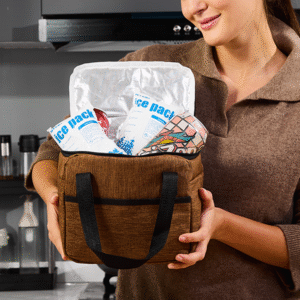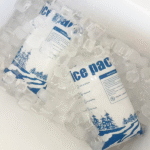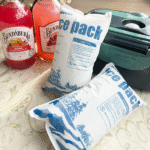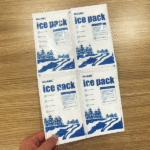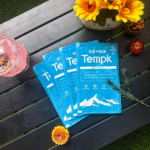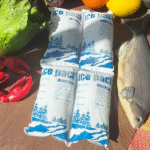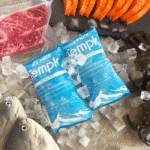Que vous expédiiez des vaccins, fruits de mer ou desserts glacés, packs de glace carbonique haut de gamme gardez vos produits au frais, plus sec et plus stable que les packs de gel standards ou les briques PCM. Contrairement à la neige carbonique ordinaire qui se sublime rapidement et laisse l'emballage humide, les packs premium combinent des coques renforcées, matériaux avancés à changement de phase et surveillance intelligente pour maintenir des températures ultra basses –78,5 °C jusqu'à 72–120 heures. Ils peuvent être réutilisés 100–200 fois avec une manipulation appropriée, vous aidant à réduire les coûts et le gaspillage tout en respectant des normes plus strictes 2025 normes réglementaires. Ce guide explique ce qui rend un sac de glace carbonique « premium,» comment le dimensionner et le manipuler en toute sécurité, et quelles tendances remodèlent la logistique de la chaîne du froid cette année.
Ce qui différencie un pack de glace carbonique de qualité supérieure des liquides de refroidissement conventionnels?
Comment les matériaux, la conception et la technologie prolongent le temps de maintien et les cycles de réutilisation.
Comment dimensionner, emballer et étiqueter la glace sèche en toute sécurité 2025 règles.
Quelles innovations, les pratiques de durabilité et les tendances du marché façonneront votre stratégie de chaîne du froid.
Réponses aux questions les plus courantes sur la réutilisation, sécurité et conformité.
En quoi les packs de glace sèche premium diffèrent-ils des options standard?
Les packs de glace sèche de qualité supérieure sont conçus pour une durée de conservation plus longue, plusieurs cycles de réutilisation et une manipulation plus sûre par rapport à la glace carbonique ou aux packs de gel standard. Les packs premium typiques maintiennent –78,5 °C pendant 72–120 heures, alors que la glace carbonique ordinaire ne peut fournir que 24 à 48 heures. Les coques renforcées et l'isolation permettent de réutiliser les packs premium 10–50 fois-ou jusqu'à 100–200 cycles dans des conceptions de premier plan : réduction des déchets d'emballage et réduction des coûts par expédition. Les packs de gel standard et les briques PCM –21 °C offrent des températures plus douces et des durées plus courtes (24–72 heures). Les packs de glace sèche de qualité supérieure intègrent également des fonctionnalités de sécurité telles que des conceptions fermées qui empêchent tout contact direct avec le CO₂ solide et réduisent le risque de brûlures par le froid., et ils sont conformes aux conformités IATA et FDA nécessaires pour le transport mondial.
Performances et réutilisation étendues
Utilisation des packs Premium polyéthylène haute densité (HDPE) ou coques composites EVA qui résistent à la fissuration à des températures inférieures à zéro. Ces coquilles entourent un matrice de changement de phase avancée (PCM) qui tamponne la température pendant que la neige carbonique se sublime, maintenir la charge utile dans les plages requises. Une troisième couche...une doublure isolée—retient la vapeur de CO₂, prolongeant la durée de refroidissement et réduisant les coûts de réapprovisionnement. Cette construction multicouche offre jusqu'à temps de maintien cinq fois plus long que de la glace carbonique ou des packs de gel à usage unique. Parce que les coques extérieures et les doublures sont durables, les packs peuvent supporter des cycles répétés de gel-dégel, permettant la réutilisation sur des dizaines d’expéditions.
Avantages comparatifs
Le tableau ci-dessous compare les packs de glace carbonique de qualité supérieure avec d'autres liquides de refroidissement courants.. Notez comment le temps de conservation et les cycles de réutilisation s'améliorent considérablement lorsque vous investissez dans une solution haut de gamme..
| Type de liquide de refroidissement | Temps de maintien typique (h) | Réutiliser les cycles | Ce que cela signifie pour vous |
| Pack de glace sèche de qualité supérieure | 72–120 | 100–200 | Intégrité du surgelé pour les itinéraires de plusieurs jours; coût total par expédition inférieur |
| Pack de glace carbonique standard | 24–48 | 10–20 | Idéal pour les expéditions d'une nuit ou de deux jours, mais génère plus de déchets |
| –21 °C Brique PCM | 24–72 | 12–24 | Convient aux couloirs de congélation partielle ou de crème glacée; manipulation plus facile |
| 0 Pack de gel °C | 24–48 | 10–20 | Idéal pour les produits réfrigérés, pas surgelé |
Conseils pratiques et recommandations
Produits et doublures de pré-refroidissement. Un démarrage à froid permet de préserver la capacité du pack et ralentit la sublimation.
La masse compte. Doubler la masse de glace carbonique peut prolonger la durée d'environ 30 heures pour 50 heures dans de vraies voies de navigation. Pour les voies d'été, ajouter un 25–50 % de tampon de masse et valider les performances avec un enregistreur de données.
Utilisez des entretoises et un flux d'air. Les charges denses nécessitent une circulation d'air autour du sac; charger par le haut ou entourer la charge utile de neige carbonique pour maximiser le contact.
Isolation en couche. Combinez du papier d'aluminium ou des pare-vapeur avec du polystyrène expansé (PSE) ou panneaux isolés sous vide (VIP) pour augmenter la valeur R et prolonger le temps de maintien.
Exemple de terrain: Une marque de repas surgelés a remplacé quatre petits packs de gel par deux packs de glace carbonique de qualité supérieure à masse élevée. Le changement a réduit le temps d'emballage de à propos 25 % tout en maintenant la température pendant 48 heures dans les rues chaudes de juillet. Cela illustre comment les packs premium réduisent le travail et améliorent les performances..
Quels matériaux et technologies rendent un pack de glace carbonique « Premium »?
Le statut premium vient des matériaux, une conception et une technologie qui offrent à la fois performances et sécurité. Les packs de glace carbonique modernes intègrent la science des matériaux, ingénierie d'isolation et capteurs intelligents pour atteindre cet équilibre.
Coques extérieures haute performance
Utilisation de packs durables Coques composites HDPE ou EVA, qui sont difficiles, léger et résiste aux fissures lorsqu'il est exposé à des températures inférieures à zéro. Ces matériaux réduisent également les fuites de CO₂, maintenir l'équilibre de la pression interne pendant la sublimation. Pour toi, cela signifie des performances de refroidissement plus longues et un risque réduit de défaillance du boîtier.
Matrice de changement de phase intégrée et doublures isolées
Alors que la neige carbonique est le principal moteur de refroidissement, un matrice de changement de phase intégrée (PCM) stabilise la température à mesure que la glace se sublime. Cette approche à double couche garantit que les produits pharmaceutiques nécessitant –20 °C à –80 °C restent dans des limites strictes.. Un doublure isolée retient la vapeur de CO₂ et prolonge la durée de refroidissement. Ensemble, ces couches réduisent les pics thermiques et offrent des temps de maintien plus longs.
| Composant | Fonction | Avantage clé | Avantage réel |
| Coque en PEHD/EVA | Fournit une résistance structurelle | Empêche la déformation et les fuites de CO₂ | Garantit une réutilisation à long terme |
| Couche PCM | Tampons de température lorsque la neige carbonique se sublime | Réduit les pics thermiques | Maintient les marchandises sensibles dans la plage requise |
| Doublure isolée | Retient la vapeur de CO₂ | Prolonge la durée de refroidissement | Réduit les coûts de remplacement et les déchets |
Capteurs intelligents et emballages connectés
Les packs premium embarquent de plus en plus Capteurs IoT qui surveille la température, niveaux d'humidité et de CO₂ en temps réel. L'emballage connecté s'appuie sur les normes de l'industrie telles que Enregistrement IATA ONE et GS1 EPCIS 2.0 pour partager les données des capteurs et les événements d'expédition de bout en bout. Les outils de routage basés sur l'IA analysent ces flux de données pour éviter les tronçons chauds et améliorer les délais en pleine performance.. Pour les expéditeurs, ces technologies réduisent les écarts de température, accélérer la résolution des sinistres et améliorer la traçabilité.
Matériaux de contrôle de sublimation et conceptions modulaires
Les polymères de nouvelle génération réduisent la perte de glace carbonique jusqu'à 30 %, alors que conceptions modulaires légères permettre une épaisseur d'isolation personnalisable pour différents types de marchandises. Les expéditeurs plus légers réduisent les coûts de transport et les émissions de carbone.
Comment taillez-vous, Manipuler et emballer les packs de glace sèche de qualité supérieure sous 2025 Règles?
Dimensionnement: Commencer par 5–10 lb (2.3–4,5 kg) de glace sèche par 24 heures pour un expéditeur isolé de taille moyenne et ajuster en fonction du volume, itinéraire et température ambiante. Pour les voies 48 heures, plan 10–15 lb; pour les itinéraires de 72 heures, 18–22 lb avec une isolation renforcée. Le tableau ci-dessous propose une règle empirique de dimensionnement.
| Volume de la boîte | Durée cible | Messe de départ | Que régler |
| 20–30L | 24 h | 5–7 lb | Ajouter 25 % messe pour temps chaud |
| 40–60L | 48 h | 10–15 lb | Ajoutez des VIP ou de la glace carbonique à chargement par le haut pour la circulation de l'air |
| 60–80L | 72 h | 18–22 lb | Ajouter un tampon et examiner les données de l'enregistreur |
Formule: Pour des estimations plus précises, un estimateur de base multiplie le volume et la durée de la boîte, puis s'ajuste aux conditions ambiantes et à l'isolation:
# Estimateur de masse de glace carbonique (base de base)# Entrées: volume_L, durée_h, ambiant = 'cool'|'modéré'|'chaud', isolation = « bonne »|'mieux'|'meilleur’
base_mass = 0.25 * volume_L * (durée_h / 24) # lb pour une température ambiante modérée et une bonne isolation
ambiant_multiplier = {'cool': 0.9, 'modéré': 1.0, 'chaud': 1.35}[ambiant]
isolation_multiplicateur = {'bien': 1.0, 'mieux': 0.8, 'meilleur': 0.65}[isolation]
requis_mass_lb = base_mass * multiplicateur_ambiant * isolation_multiplierprint(rond(requis_mass_lb, 1))
Exécutez cette simple calculatrice pour dimensionner correctement votre paquet avant l'expédition.. Validez toujours les résultats avec un enregistreur de données et ajustez en fonction des voies réelles.
Exigences en matière d'emballage et d'étiquetage (2025)
La glace carbonique est réglementée comme Et 1845, Classe 9 marchandises. Les colis doivent permettre au gaz CO₂ de s'échapper et être clairement étiquetés. Suivez ces étapes:
Choisissez un rigide, récipient isolé— Glacières en polystyrène ou en plastique à l'intérieur d'un carton, boîte en plastique ou en bois – capable de résister à des températures inférieures à zéro. Évitez les sacs en plastique scellés ou les boîtes métalliques scellées qui pourraient se briser.
Évacuer le conteneur. Ne pas sceller hermétiquement les coutures; laissez un espace de la largeur d'un doigt ou des trous d'aération pour que le CO₂ puisse s'échapper. Les compagnies aériennes peuvent refuser les boîtes en polystyrène scellées.
Le placement compte. Placez la neige carbonique au-dessus de la charge utile; Le CO₂ est plus lourd que l'air, donc le chargement par le haut garde le produit plus froid. Utilisez des entretoises pour améliorer la circulation de l’air.
Sceller et étiqueter. Fixez le couvercle mais assurez-vous qu'il peut s'aérer. Étiquetez le colis avec « Glace sèche » ou « Dioxyde de carbone », solide,» le Et 1845 code, le Poids net de la glace sèche, et appliquer le Classe 9 symbole de danger. Retirez les anciens autocollants de danger pour éviter toute confusion.
Respecter les limites de poids. Les voyageurs personnels peuvent transporter jusqu'à 2.5 kg (5.5 kg) par segment de vol, avec approbation des compagnies aériennes. Les expéditions de marchandises sont plafonnées à 200 kg de glace carbonique par colis sous IATA PI 954. L'air intérieur USPS autorise généralement uniquement 5 kg.
Préparer la documentation. Inclure le nom d'expédition approprié, Numéro de l'ONU, nombre de colis et poids net sur la lettre de transport aérien. Certaines expéditions peuvent nécessiter une déclaration de l’expéditeur; consultez votre opérateur.
Formez votre équipe. Emballage du personnel, le marquage ou la manipulation de glace carbonique doivent recevoir une formation sur les matières dangereuses. Mettre régulièrement à jour les SOP pour refléter 2025 changements de réglementation.
Erreurs courantes pour éviter
Mauvaise ventilation: Ne jamais sceller complètement les contenants; ne pas ventiler les emballages peut entraîner une accumulation dangereuse de pression.
Étiquetage incorrect: ONU manquante ou incorrecte 1845 les étiquettes ou le poids net peuvent retarder les expéditions ou entraîner des amendes.
Surcharge des paquets: Ne dépassez pas 200 kg par colis pour le transport aérien.
Utiliser des matériaux inadéquats: Évitez les contenants fragiles ou non approuvés; ils peuvent provoquer des fluctuations de température.
Conseils adaptés aux voyageurs
Si vous transportez de la neige carbonique en tant que passager, par exemple, transporter des échantillons congelés ou une glacière lors d'un voyage en voiture : gardez les points suivants à l'esprit:
La limite personnelle est 2.5 kg (5.5 kg) par segment. Obtenez l'approbation de la compagnie aérienne et pesez votre glace avec précision.
Laissez un espace de la largeur des doigts ou des trous d'aération pour éviter l'accumulation de pression.
Imprimer deux étiquettes: un pour le sac extérieur et un pour la glacière à l'intérieur.
Utilisez des tampons absorbants lors du transport de viande ou de poisson pour absorber la condensation.
Pourquoi les packs de glace carbonique haut de gamme sont-ils à la mode 2025? Innovations et perspectives du marché
Les packs de glace carbonique de qualité supérieure sont au cœur du 2025 transformation de la chaîne du froid. Plusieurs facteurs déterminent leur popularité:
Durabilité et logistique circulaire
Réutilisation et recyclage. Les packs Premium peuvent être réutilisés 100–200 fois, réduire considérablement les déchets. Conteneurs réutilisables, Les systèmes de récupération du CO₂ et la logistique de retour intelligente réduisent les déchets de 60 % et soutenir les modèles économiques circulaires.
Captage du CO₂ et production écologique. La neige carbonique est un sous-produit du captage industriel du CO₂, et certains fournisseurs s'approvisionnent en CO₂ à partir de la fermentation du bioéthanol. Le choix d'emballages réutilisables avec des boîtiers recyclables minimise encore davantage l'empreinte carbone.
Adoption par l'industrie. Dans 2025, sur 70 % des prestataires logistiques pharmaceutiques mondiaux adoptent des emballages réutilisables pour atteindre leurs objectifs de neutralité carbone.
Emballage intelligent et intégration de données
Packs compatibles IoT mesurer continuellement la température, taux d'humidité et de CO₂. Les données circulent VOICI UN enregistrement et GS1 EPCIS 2.0 normes, donner aux parties prenantes une vision partagée de l’état du produit.
Optimisation de l'itinéraire IA utilise les données des capteurs pour éviter les pics de chaleur, réduire les réclamations et améliorer les délais de livraison.
Documentation numérique comme les lettres de transport aérien électroniques (Charme) rationaliser la paperasse et la conformité.
Avancées dans les matériaux et la conception
Polymères de contrôle de sublimation réduire la perte de glace carbonique jusqu'à 30 %, amélioration de l'efficacité thermique.
Conceptions modulaires légères permettre aux expéditeurs de personnaliser l'épaisseur de l'isolation en fonction des exigences de la cargaison.
Packs de glace carbonique intelligents avec des capteurs intégrés, fournissez des données de localisation et de température en temps réel.
Croissance du marché et tendances régionales
La demande mondiale d’emballages de glace carbonique durables devrait augmenter grandir 18 % chaque année à travers 2028, tiré par l’expansion de la chaîne du froid pharmaceutique et du commerce électronique. Les packs de glace carbonique réutilisables devraient représenter 45 % de toutes les expéditions à température contrôlée par 2027, à partir de 22 % dans 2022. L'Asie-Pacifique est en tête de l'adoption grâce à sa base croissante de fabrication de produits biologiques et à ses marchés d'exportation de produits de la mer.
Questions courantes sur les packs de glace sèche de qualité supérieure
Q1: Combien de temps durent les packs de glace carbonique premium?
Les packs Premium maintiennent des températures ultra basses pendant 72–120 heures, en fonction du volume, isolation et conditions ambiantes. Les packs de gel standard ne durent que 24 à 48 heures.
Q2: Les packs de glace carbonique haut de gamme sont-ils sûrs pour le transport aérien?
Oui. Les conceptions modernes sont conformes Instruction d'emballage IATA 954, qui nécessite une ventilation, Et 1845 étiquettes, et les limites de 200 kg par forfait. Les voyageurs personnels sont limités à 2.5 kg. Toujours étiqueter et ventiler les emballages correctement.
Q3: Les packs de glace sèche de qualité supérieure peuvent-ils être réutilisés?
Absolument. Selon le modèle, ils peuvent être réutilisés 100–200 fois. Inspectez les emballages pour déceler des fissures ou des joints compromis avant de les réutiliser et retirez les unités endommagées..
Q4: Comment les packs de glace sèche premium se comparent-ils aux packs PCM ou gel?
Les packs de glace sèche fournissent le froid le plus profond (–78,5 ° C) et durée la plus longue. Les briques PCM offrent un Consigne –21 °C pendant 24 à 72 heures, tandis que les packs de gel maintiennent les produits à 0–8 ° C pendant 24 à 48 heures. Choisissez en fonction des exigences de température et de la longueur de l'itinéraire.
Q5: Quelle est la meilleure façon de se débarrasser de la neige carbonique?
Laissez la glace carbonique restante se sublimer dans un endroit bien ventilé, loin des personnes et des animaux domestiques.. Ne le jetez pas dans des espaces confinés ou dans les égouts. Recyclez le boîtier extérieur s'il est en plastique recyclable; consultez votre programme local.
Résumé et recommandations
Les blocs de glace carbonique haut de gamme offrent des performances de surgélation, une réutilisabilité et une conformité que les liquides de refroidissement conventionnels ne peuvent égaler. Ils maintiennent –78,5 °C pendant jusqu'à cinq jours et peut être réutilisé 100–200 fois, réduisant à la fois les coûts et les déchets. Coques hautes performances, Le tampon PCM et les doublures isolées assurent la stabilité thermique, tandis que les capteurs intelligents et le partage de données standardisé améliorent la visibilité et réduisent les réclamations.. Lors du dimensionnement de votre pack, commencer par 5–10 lb par 24 heures, ajoutez de la masse pour les itinéraires chauds et pré-refroidissez votre charge utile. Suivez toujours Voici pi 954 lignes directrices: évacuer le colis, étiquetez-le avec Et 1845 et poids net, et restez dans les limites de poids. Avec la durabilité et la technologie intelligente qui accélèrent l’adoption, les packs de glace carbonique haut de gamme sont un investissement essentiel pour tout 2025 stratégie de la chaîne du froid.
Étapes suivantes
Auditez votre chaîne d'approvisionnement en emballages. Identifier les expéditions qui utilisent encore des packs de gel à usage unique ou de la neige carbonique standard.
Packs pilotes premium. Testez des packs de glace carbonique premium sur vos itinéraires les plus longs ou les plus sensibles. Utiliser des enregistreurs de données pour valider le temps de maintien et la stabilité de la température.
Mettre en œuvre la logistique de retour. Travaillez avec votre transporteur pour établir un système en boucle fermée pour le retour et la désinfection des emballages réutilisables..
Formez votre équipe. Assurez-vous que le personnel connaît 2025 exigences en matière d'étiquetage et de ventilation.
Adoptez une surveillance intelligente. Intégrez les capteurs IoT et la documentation numérique (UN enregistrement, EPCIS 2.0) pour réduire les réclamations et améliorer la traçabilité.
À propos du tempk
Nous sommes un spécialiste de la chaîne du froid engagé à emballage avancé de glace carbonique et de contrôle de la température. Nos packs de glace carbonique haut de gamme combinent une sublimation optimisée, isolation modulaire et capteurs intelligents en option pour garantir la sécurité et la conformité de vos produits. Nous tenons ISO 9001 et 14001 attestations, et nos solutions répondent VOICI DGR, OMS PQS et FDA normes. En mettant l'accent sur des conceptions réutilisables et recyclables, nous aidons nos clients à réduire leurs déchets et à atteindre leurs objectifs de développement durable. Prêt à optimiser votre chaîne du froid? Contactez-nous pour un guide de dimensionnement personnalisé et un audit d'emballage.






